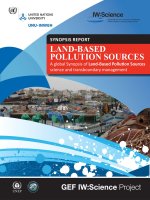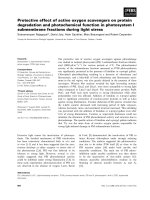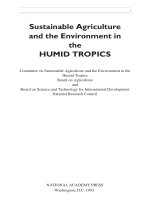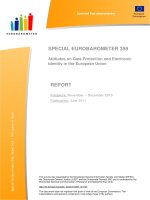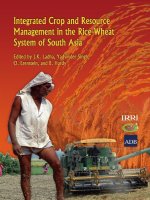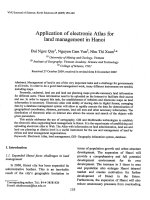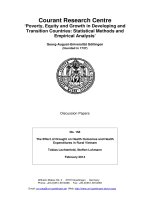The impacts of land certification on sustainable investments and land management in ethiopia the case of duna wereda, hadiya zone, SNNPR, ethiopia
Bạn đang xem bản rút gọn của tài liệu. Xem và tải ngay bản đầy đủ của tài liệu tại đây (1.12 MB, 104 trang )
ADDIS ABABA UNIVERSITY
COLLEGE OF SOCIAL SCIENCE
DEPARTMENT OF GEOGRAPHY AND ENVIRONMENTAL STUDIES
The Impacts of Land Certification on Sustainable Investments and Land Management in
Ethiopia; The Case of Duna Wereda, Hadiya Zone, SNNPR, Ethiopia.
By
KEBEDE ABERA
Advisor
ASMAMAW LEGASS (PhD)
Addis Ababa University
June, 2017
I
ADDIS ABABA UNIVERSITY
COLLEGE OF SOCIAL SCIENCE
DEPARTMENT OF GEOGRAPHY AND ENVIRONMENTAL STUDIES
A thesis Submitted to the Department of Geography and Environmental Studies, Addis Ababa
University in partial fulfillment for the requirement of degree of Master of Arts in Geography
and Environmental Studies Specialization in Land Resource Management
By
KEBEDE ABERA GASHAW
Advisor
ASMAMAW LEGASS (PhD)
Addis Ababa University
June, 2017
II
ADDIS ABABA UNIVERSITY
COLLEGE OF SOCIAL SCIENCE
DEPARTMENT OF GEOGRAPHY AND ENVIRONMENTAL STUDIES
A thesis Submitted to the Department of Geography and Environmental Studies, Addis Ababa
University in partial fulfillment for the requirement of degree of Master of Arts in Geography
and Environmental Studies Specialization in Land Resource Management.
Signatures
Date
1. Internal, Examiner
---------------------------------
------------------
--------------
----------------
------------
-----------------
-------------
2. External, Examiner
--------------------------3. Advisor
----------------------------
III
Certification
I certify that MA thesis entitled “The impact of Land Certification on Sustainable Investments
and Land Management in Ethiopia; The Case of Duna Wereda, Hadiya Zone, and SNNPR”, was
carried out by Kebede Abera under my supervision and hereby I recommend this thesis for
examination.
Asmamaw Legass (PhD)
_______________
Signature
IV
_______________
Date
Acknowledgments
This research would never have become visible without the contribution of many people to
whom the pleasure of expressing my appreciation and gratitude. First, I would like to express my
sincere and deepest thankfulness to my supervisor Asmamaw Legass (PhD) for his unlimited
support, critical comments and continuous discussions were very invaluable and inspiring in the
process of the proposal writing research task and thesis writing.
My sincere thanks also to state all staff members of Geography and Environmental studies for
their priceless assistance and encouragement. Special thanks are also to Tebarek Lika Head,
Department of Geography and Environment Studies and Fekadu Gurmessa PG Coordinator,
Department of Geography and Environment Studies for their all round support and
encouragement throughout my research work.
I am thankful to the farmers of the Wereda. Without their acceptance and contribution to share
their time, primary data collection would not have been possible. I thank them very much for
providing information and openly answering my questions. My appreciation extends to those
experts (DAs, supervisors) who most helpful in the data collection. I am more indebted of Duna
Wereda agriculture and rural development office, land administration and use office and wereda
court for their support while collecting data. Lastly but not least, I would like to express my
deepest thankfulness to my wife Berihanesh watumo , my sisters Abaynesh Abera and Workenh
Dolaso for their financial support and moral encouragement.
i
Table of Contents
page
Acknowledgment---------------------------------------------------------------------------------------------i
Tables of Contents--------------------------------------------------------------------------------------------ii
List of Tables--------------------------------------------------------------------------------------------------v
List of figures-------------------------------------------------------------------------------------------------vi
Acronyms----------------------------------------------------------------------------------------------------vii
Abstract -------------------------------------------------------------------------------------------------------ix
CHAPTER ONE ..............................................................................................................................1
INTRODUCTION ...........................................................................................................................1
1.1 Background of the Study…………………………………………………………………… 3
1.2. Statement of the Problem………………………………………………………………….. 4
1.3 Objectives of the Study…………………………………………………………………….. 5
1.4 Research Questions………………………………………………………………………… 5
1.5 Significance of the Study…………………………………………………………………... 6
1.6 Scope of the Study…………………………………………………………………………..6
1.7 Limitation of the study……………………………………………………………………. 7
1.8 Conceptual framework……………………………………………………………………... 7
1.9 Operational Definition of Terms…………………………………………………………… 8
1.10 Organization of the Study………………………………………………………………….9
CHAPTER TWO ...........................................................................................................................10
REVIEW OF RELATED LITERATURE .....................................................................................10
2.1 The Concepts of Land Policy Issues……………………………………………………… 11
2.2 The Concepts of Land Administration……………………………………………………. 14
2.3 The Concepts of Land Tenure…………………………………………………………….. 15
2.4 Landholding and Use Rights……………………………………………………………….16
2.4.1 Category of Landholding Rights……………………………………………………......16
ii
2.5 Tenure Security and Land Rights…………………………………………………………… 19
2.5.1 Essential Features of Security of Land Rights
19
2.5.2 Influence of Security Land Rights on Agricultural Productivity………………………..20
2.6 Women Land Rights………………………………………………………………………… 21
2.7 Land Tenure under the FDRE Regime (Since 1991)………………………………………...22
2.8 Land Certification…………………………………………………………………………… 24
2.8.1 Land Certification in Africa…………………………………………………………..
25
2.8.2 Land Certification in Ethiopia………………………………………………………….. 27
2.8.3 The Impacts of Land Certification……………………………………………………… 28
CHAPTER THREE .......................................................................................................................29
STUDY AREA AND RESEARCH METHODOLOGY ...............................................................29
3.1 Description of the Study Area……………………………………………………………….. 29
3.1.1 Bio-physical Characteristics of the Study Area………………………………………… 31
3.1.2 Socio-economic Characteristics of the Study Area…………………………………….. 31
3.2 Methodology of the Study……………………………………………………………………32
3.2.1 Mixed Method Research Design………………………………………………………...32
3.2.2 Data Source……………………………………………………………………………... 33
3.2.3 Instrument of Data Collection………………………….………………………………..33
3.2.4 Sampling Technique and Sample Size…………………………………………………..33
3.2.5 Data Analysis and Interpretation……………………………………………………….. 35
3.3 Ethical Consideration………………………………………………………………………... 35
iii
CHAPTER FOUR ..........................................................................................................................38
THE IMPACT OF LAND CERTIFICATION ON SUSITAINABLE INVESTMENTS AND
LAND MANAGEMENT...............................................................................................................38
4.1 Demographic Characteristics of the Sample Households…………………………………
38
4.1.1 Sex and Age of the Studied Households………………………………………………...39
4.1.2 Educational Background………………………………………………………………... 39
4.2 Farm Landholding Characteristics…………………………………………………………...41
4.2.1 Permanent Holding…………………………………………………………………...
42
4.2.2 Temporary Holding……………………………………………………………………...43
4.3 Farmers‟ Views on Land Registration and Certification………………………………….
44
4.4 Securing of Land Rights in Duna Wereda………………………………………………… 46
4.5 Farmers‟ knowledge on Basic Land Rights and Use Obligations………………………… 49
4.6 Investments on Land Management and Soil fertility Management/ILMand ISFM/…….......52
4.7 Farm Land Productivity…………………………………………………………………… 53
4.8 Land Related Disputes after Land Certification…………………………………………... 55
4.9 discussion with wereda court………………………………………………………………...57
4.10 discussion with Selected farmers ………………………………………………………......58
CHAPTER FIVE ...........................................................................................................................59
CONCLUSIONS AND RECOMMENDATIONS ........................................................................59
5.1 Conclusions ..............................................................................................................................59
5.2 Recommendations……………………………………………………………………………61
Reference……………………………………………………………………………… 63-76
Appendices.......................................................................................................................77-90
iv
List of Tables
Page
Table 4.1: Distribution of Sample Households by Sex……………………………………. 38
Table 4.2: Educational Background of the Sample Households……………………………40
Table 4.3: Landholding/Acquiring Status of the Studied Households…………………….. 41
Table 4.4: Farmers‟ Views on Land Certification and Registration………………………. 44
Table 4.5: Respondents‟ Views of Securing of Land Rights……………………………… 45
Table 4.6: Knowledge of Respondents on Basic Land Rights…………………………….. 47
Table 4.7: Knowledge of Respondents on Basic Land Use Obligation…………………… 49
Table 4.8: Investments in Land Management Practices…………………………………… 51
Table 4.9: Investments in Soil Fertility Management………………………………………52
Table 4.10: Farm Land Productivity………………………………………………………. 54
Table 4.11: Land Certification as Guarantee for Getting Credit…………………………... 57
Table 4.12: Farmers‟ View on Land Related Disputes……………………………………. 58
Table 4.13: Rank of Land Cases to Court................................................................................60
v
List of Figures
Page
Figure 1.8; Conceptual framework……………………………………………………..……..7
Figure 3.1: Map of the Study Area……………………………………………………..........28
Figure 4.1: Age Category of the Sample Households………………………………………..37
Figure 4.2: Trend in Crop Production in Duna Wereda…………………………………… .53
Figure 4.3: Trend in the Price of Fertilizer………………………………………………… .54
vi
Acronyms
ANR
Amhara National Region
CSA
Central Statistic Agency
DA
Development Agents
ECA
Economic Commission for Africa
EEA
Ethiopian Economic Association
EEPRI
Ethiopian Economic Policy Research Institute
EPLAUA
Environmental Protection and Land Administration and Use Authority
F
Frequency
FAO
Food and Agricultural Organization
FDRE
Federal Democratic Republic Ethiopia
GIS
Geographical Information System
HHs
Households
IFAD
International Food for Agricultural Development
ILC
International Land Coalition
ILM
Investments on Land Management
ISFM
Investments on Soil Fertility Management
MOA
Ministry of Agriculture
RRR
Rights, Restrictions and Responsibilities
SNNPR
South, Nations, Nationalities, Peoples and Region
SPSS
Statistical Package for Social Sciences
vii
UNECE
United Nations Economic Commission for Europe
USAID
United States Agency for International Development
viii
Abstract
The objective of this study at the impacts of land certification on sustainable investments on land
management in the study area. Sample kebeles Awoya-Berkuncho, Goda-kenkicho and SemenWagebeta were selected purposively sampling technique. Primary data were collected through
survey questionnaire, group discussion, key informant interview and field observation, while
secondary data were collected from governmental organizations carried out in three
administrative kebeles from the total thirty two kebeles. The data were analyzed by using verbal
description and statistical analyses (correlation analysis). The result of correlation is confirmed
that, there is a positive and significant relationship between investments on land management
and land certification. The result showed that tenure security was low during the past regimes
because of frequent land redistribution and this contributes a lot towards natural resource (land)
degradation in the wereda. However, in response to the problem the current government has
taken measures of rural land certification to increase tenure security by granting holding
certificate as legal evidence. In addition, land related disputes are decreased and the vulnerable
group of the society especially women land rights are protected as a result of holding certificate.
Moreover, there was low productivity of farm because of increasing price of inputs such as
fertilizer and low awareness for certificate as collateral /guarantee/ to the financial institute. In
general, the findings of the study demonstrate that the feeling of land rights security is increasing
through time, while land certification carried out to increase tenure security has been achieving
its intended objectives and is sustainably effective in improving investments on land management
of landholders in the study wereda.
Key words: Land policy, Land administration, Land tenure, Land rights, Land certification,
Land management.
ix
CHAPTER ONE
INTRODUCTION
1.1 Background of the Study
Land is one of the most important natural resources of the people throughout the world
especially for the rural as well as urban farmers whose livelihood basically relies on agriculture
(USAID, 2007). Managing natural resources and controlling the environmental impacts
associated with land use change requires an understanding of the underlying causes, which arise
out of complex interplay between bio-physical and socio-economic factors (Serneels and
Lambin, 2001; Fox, 2002; Muller, 2003; Rasul et al., 2004). The socio-economic and biophysical factors are affecting land use/cover change, land tenure security has been increasingly
recognized as a critical element in reducing poverty, promoting social equality, developing
sustainable agriculture and conserving natural resources. There is a general consensus that land
tenure security promotes investment and efficient use of resources (ILC et al., 2004).
However, land tenure insecurity may leads to the risk of losing land will create a disincentive to
undertake investments even if the present value of the productivity benefits from such
investments. Tenure insecure also obstacle for the functioning of land markets, and the use of
land tenancy is insecure, farmers do not care much about the land use and though concentrate on
short terms profits maximizing at the cost of accelerating the degradation of land (Lanjouw, and
Levy, 2002; Carter and Olinto, 2003; Deininger and Chamorro, 2004) and Similarly, lack of
access to land or low return per area of land, leads to the expansion of agriculture into forested
areas and the degradation of natural resources. For instance, the provision of land tenure to
farmers can be effective solution land degradation, land conflicts and environmental problems
(Do and Iyer, 2002).
Secure land certification, has positive impact on sustaining profitable farming that is less
destructive to the environment (Ayalew et al., 2005). Land certification had significant impacts
on investment in Latin America and Asia, whereas, such interventions in Africa have found
insignificant. For instance, in Kenya, there was no empirical evidence that showed land
certification enhancing credit markets, land markets, and investment (Holden et al., 2009). A
Study carried out by Migot-Adholla and others looked at the use of credit, land improvements
1
and productivity and how land registration in Kenya was related to these variables. Nonetheless,
Holden et al. (2009) in the Southern Kenya reported that poverty had a significant negative
impact on trees investment but no evidence on tenure insecurity having a negative impact on
trees investment. Similarly, Nedessa et al. (2005) reported that one study in Kenya indicates that
tenure security is important, however, privatization alone does not guarantee improvement in
land and agricultural production. In some cases, privatization has led to different land rights
being concentrated in the hands of a few people while other people (such as poor rural women or
ethnic minorities) lose the few rights they have and generally are not able to participate fully in
the land market (Laustarria-comhiel, 1997).
The problem of land tenure security is serious in the developing countries, especially African
agricultural activities and other livelihood of smallholders options are affected by various factors
(climatic conditions, markets, infrastructure, physical conditions), unequal access to land and
land tenure insecurity have the most profound effect (ECA, 2004). Most of the land tenure
challenges facing Africa are legacies of the colonial period. The process of colonization was
driven by the economic imperatives of establishing markets for European goods, exploitation of
mineral resources and the establishment of European agriculture. A unique feature of colonialism
in Africa is that it defined land as a communal and customary possession (Mamdami, 1996). This
was further complicated by inappropriate land tenure policies have, therefore, resulted in various
forms of economic, environmental and social impacts (Ouedraogo, and Toulmin, 1999).
The linkages of land tenure, food security and sustainable development helps to compare the
efficacy of different sets of perspectives on the evolution of land tenure in Africa and its role in
politics and development in the historical evolution of land problems. While the notion of tenure
security tends to be equated with the individualization of landholdings, in this continent the
existing complex tenure relations suggest that there is no single tenure form that offers absolute
security. The co-existence even association in some cases of various forms of tenure in Ethiopia
including state, communal, customary, and private or individual rights suggests the need to
develop more complex policy, which discourage them to increase agricultural production and
land resources over long term conservation (Tigistu, 2011).
The effective, success and sustainability of investments on land management depend on clear
understanding of land tenure security through land certification to increase agricultural
2
productivity. However, the impacts of land certification on investments and securing land rights
should be investigated to measure the contribution of land registration and certification on
sustainable investment in land management, and agricultural productivity (Ayelaw, 2011).
1.2. Statement of the Problem
The impact of land certification on sustainable investment and land management is one of the
most important effects on improvement of conservation structures. Having a land certificate for a
farm plot enhances investments on the plot in the construction of a new structures, improvement
/maintenance of the existing conservation structures. And also land certification has enhanced
land productivity (Tekie, 2008).
Land tenure security is believed to be important in improving investments in land, land
management, environmental stability, sustainable use of natural resources and agricultural
productivity. However, the possible impacts of land certification on tenure security, proper
utilization of land, improving investments in land and dispute resolution is arguable in the case
of study area. It is believed that the insecurity of land rights exacerbate land degradation,
overgrazing and poor performance of agricultural activity. In addition, it suggested that the
indicators of poor performance of agricultural sector under the existing tenure arrangement are;
insecurity of holding rights, reduction of holding size and subsistence farming practices (Sabita,
2010). While the certification program, and the resulting increased tenure security is expected to
have both short and long-term impacts in enhancing productivity. Moreover, the current land
tenure system which is vested in the public and under the control of the state is considered as a
problem to achieve sustainable investments on land management activities. As a consequence,
the issues of land became the point of different actors who have interest in land. For instance,
Adenew et al. (2003) found that landholders were not willing to make sustainable investment on
land, because of the fear of future redistribution and land taken by government at any time.
Furthermore, the land reform in Duna wereda in the Derg regime which was implemented in
1975 was another problematic area of the land reform which resulted in frequent land
distribution. It was believed that fragmentation of land, insecurity of tenure and shortage of farm
inputs were the results of land distribution. In addition, it was also pointed out that investments
in land improvement measures were not carry out by many landholders such as tree planting,
3
terracing and in soil fertility management such as crop rotation, intercropping, compost etc
because of the fear that they were not be compensated for the development they made in their
land. Conversely, the current government policy trends discloses that the chance to carry out land
distribution looks to be very little. This may be an important measure to guarantee landholding
rights by granting a certificate holding as legal evidence. To this end the land administration
institute is established at a grass root level (Nezioki, 2006).
Another significant feature of the problem lays on the fact that land certification is a recent
phenomenon in the study area which possibly creates knowledge gap in terms of its impact.
Despite the fact that land certification was implemented over the last six years, little was known
about the impact of certification on tenure security, investments in land, dispute over land and
the perception of farmers about security of land rights.
Accordingly, based on the existence of the knowledge gap in the topic under discussion, one of
the primary reasons for conducting this study was to fill the knowledge gap about the impact of
land certification on farm activities. Above all, insecurity of the land rights has diversified
implication that can affect the social and economic wellbeing of farmers. The main indication of
tenure insecurity comprises poor performance of agricultural sector, lack of incentives for the
land based on investments at household level, legally recognized women land rights being
impracticable, discourage development of rental market and increasing land disputes in the study
area. Moreover, in some cases farmers are obliged to waste resources to protect their land rights
(Place, 2008). In such situation, it is imperative to study how farmers were responding to
government intervention on rural land certification that aims to build tenure security and made
use of land more productive. However, the impacts of land certification in securing land rights,
the impacts of land certificate on sustainable investments on land management and
farm/agricultural productivity has not been studied in Duna wereda. Therefore, it is timely to
investigate land certification related problems and prospects on the ground and in view of farm
households as government policy on security is changing overtime.
4
1.3 Objectives of the Study
The general objective of this study is to assess the impacts of land certification on the investment
and sustainable land management, in Duna Wereda, Ethiopia.
The specific objectives of study attempts to-:
i.
assess farmers‟ view towards land certification.
ii.
evaluate the impact of land certification in securing land rights.
iii.
examine the effectiveness of land certification on land investment, management and farm
productivity.
iv.
assess the impact of land certification in resolving land - related disputes.
v.
evaluate farmers‟ knowledge of basic land rights and obligations in relation to land
certificate of the study area.
1.4 Research Questions
Based on the proposed objectives the research attempts to answer the following questions
1. What is the view of farmers towards land certification?
2. What are the impacts of land certification in securing land rights?
3. What impacts on farm productivity occurs after issuing land certification?
4. Does land certification reduce the extent of land-related disputes resolution?
5. How is the knowledge of farmers of basic land rights and obligations in relation to land
certificate of the study area?
5
1.5 Significance of the Study
The results of the study will have the following multitude significances:
a) It will help the farmers to carry out sustainable land management practices and soil
fertility management to increase farm productivity in the study area
b) It will help experts to understand the impacts of land management practices and create
awareness about efficient use of resources.
c) It will enable the wereda‟s stakeholders to recognize the perception of the farmers
towards the impact of land certification on enhancing agricultural production.
d) It will enable the farmers to realize the impact of securing of land rights leads to incentive
that promotes investments and efficient use of resources.
e) It will reveal to planners and policy makers the solution through which land certification
to reduce the extent of land-related disputes.
f) The study will make stronger public awareness of land rights and obligations in relation
to land law/certificate on the status of land certification in the study area to bring
sustainable investments on land management.
1.6 Scope of the Study
This study is conducted in Duna District of Hadiya Zone, Southern Nation, Nationalities and
Peoples of Regional states, Ethiopia. The study mainly investigates the impacts of land
certification on practices of land management and tenure security as one of the contributions for
production improvement in the study area. This study does not look into other factors
contributing for crop production such as improved seed, etc. There was no much attention given
to traditional land tenure system of the area. This research tries to show the link between land
certification and sustainable land management and investment on it.
1.7 Limitation of the study
Although large sample size is required to deal with the issue under investigation, due to
limitation of time, the sample size was restricted to 84 households. Farmers were reluctant to
provide accurate data on landholding related to income they get. This hindered comparison of
income and expenditure among households, though much work has been done to create
awareness about the objective of the research. The absence and fear of respondents to provide
6
genuine and accurate information for questions posed were among other important impediments
faced the researcher although absent households were substituted by the next available
households.
1.8 Conceptual framework
The general conceptual framework of this study is conducted on the idea how the land policy
framework is initially formulated at the federal level in the proclamation and then each region
has prepared its own regional land proclamation and related implementation on regulation. The
effect of in implementation of land registration and certification program on security of land
rights, land related investment and land dispute are assessed based on farmers condition before
and after rural land certification. Figure (1) shows the relationship of the concepts used in this
research.
Federal
government
Federal land
proclamation
Regional land
proclamation and
implementation
regulations
Regional
government
Land registration and
certification
implementation
Impacts of land certification
-
Farmers land
management activities
before and after land
certification
Security of land rights
Land investments
Resolution of Land
dispute
Fig.1.8: Conceptual framework of the research process
7
1.9 Operational Definition of Terms
Agrarian: the farming units in a society, including the pattern of land distribution among rural
landholders (Duna Wereda land Administration office, 2007)
Belg: Ethiopian season which include the month February to April (Metrological Station, 1992)
Certification/Certificate: the evidence of a person‟s right to land, or entitlement (Tigistu, 2011).
Kebele: A peasant association; it is also the lowest administrative unit in rural Ethiopia (FDRE,
1997)
Kiremt: The rainiest season in Ethiopia this includes the month of June to August (Duna Wereda
Meteorological Station, 1992)
Land administration: the set of systems and processes for making land tenure rules operational
(Steudler etal, 2004)
Land dispute: a disagreement over land rights, boundaries or uses.
Land registration: the recording of rights to land in some form of public register (Tigistu,
2011).
Parcel: a portion of land for which distinct rights exist (Tuladhor, A.M, 2004)
State ownership: the rights to land held by the state, often by assignment to a public agency
(FDRE, 1997: SNNPR, 2004)
Wereda: An administrative unit somewhat equivalent to a district. A wereda consists of several
peasant associations (FDRE, 1997)
Zone: An administrative unit somewhat having different district. A Zone consists of several
Wereda (From Hadiya zone Administrative office document, 1995)
8
1.10 Organization of the Study
The study is organized in five chapters mentioned here under. The first chapter is an introductory
part which incorporates background of the study, statement of the problem, objectives, and
research questions, significance of the study and limitations of the study.
The second chapter deals with the concepts based on literature relevant to the study. It includes
concepts of land, land policy, land administration, land tenure, land rights, land holding and use
rights. Also, it deals with Ethiopian current land tenure, land certification in Africa and land
certification in Ethiopia.
The third Chapter presents a detailed account to the study area, including bio-physical and socioeconomic characteristics of the study area. It also presents the methods carried out to accomplish
the research, including the research design, data sources, sample size and sampling techniques,
instruments of data collection, data analysis and interpretation, ethical consideration, validity and
reliability.
Chapter four presents the results and discussion of household‟s survey, DAs‟ and other
agriculture experts‟ survey and wereda government organizations office‟s written documents on
the impacts of land certification on investment on land management in the study area. Finally,
Chapter five concludes the research and suggests possible recommendations of the study.
9
CHAPTER TWO
REVIEW OF RELATED LITERATURE
2.1 The Concepts of Land Policy Issues
Land has various definitions. Some of the definitions of land include the following: Land refers
to relevant resources of the earth that are essential for the survival of life (Van der Molen, 2002).
Land can be also described in a wider sense from legal point of view which refers to any portion
of the earth surface where land rights are exercised and such rights are not just ownership to the
surface and it includes every object attached to it above or below the surface (Tuladhar, 2004).
Since, land has a multi-dimensional impact on every society, effective and efficient management
is a vital prerequisite for economic development and environmental sustainability. Therefore,
land policy of country whether developed or developing; has a crucial role to make sure
sustainable development and the way governments deal with land is an important issue of
government development policy.
Land policy is a guideline to use land for economic development, equity and social justice,
environmental protection and sustainable land use (UNECE, 1996). Usually, the land policy of a
country is expected to be implemented based on the legal framework. Thus, there are four major
tools which have been used by governments in the implementation of land policies. These are
improving land tenure security, regulating land markets, land use planning and land taxation
(Van der Molen, 2002). Moreover, land policy reform serves a number of purposes, which may
include: 1) enhancement of security of tenure and providing the basis for determining
mechanisms for distribution of land rights among citizens, (2) promotion of social stability by
providing a clear statement of government goals and objectives towards land (3) basic for
economic development because decision making is based on expectations and certainty, (4)
ensuring sustainable land use and sound land management, and (5) guidance for the development
of legislation, regulations, and institutions to implement the policy and monitor its impact (Bell,
2006).
As stated above, the purpose of land policy is to ensure tenure security, sustainable use of land
resource and the focus on the formulation of legislations which can allow institutions to inspect
the effects of the policy. Thus, land policy is a guideline that states government‟s strategies and
10
objectives for social, economic and environmental use of the land and natural resources.
Moreover, it is considered as a tool to draft all features of land acquisition methods and the social
and legal tenure regimes.
In addition, it has been said that, because of the land policy, most farmers have led to operate
farms too small to make sustainable and profitable use of technologies difficult. Moreover, some
argue, given the current level of farm productivity and investments, the average farm size
become unviable as a farm unit and so unable to support the livelihood of people dependent on it.
Therefore, they argue that tenure insecurity is the result of the land policy (Gebreselassie, 2006).
Furthermore, it was identified that future challenges with problems of landlessness, reduction of
farm size, insecurity of tenure and week land rights, reduction of the productive capacity of the
land, rigidity in land policy to be adjusted according to growing land pressure factors, and legal
and institutional failures are considered as formidable challenges of land policy issues (Nzioki,
2006). However, nowadays measures have been taken towards slowing down or avoiding land
redistribution, certification of sustainable use rights to land, individualization of the commons
with conditional and contracts, instituting a land use policy, and establishing land administration
a local level.
Another current policy shift is about the registration of holding rights and granting certificate of
holding to all rural landholders. It is clear that the ultimate objective of certification is to ensure
landholders that they have perpetual holding rights. Besides, it has been stated that the need to
institutionalizing a land use policy and the establishment of technically capable rural land
administration institutions of a local level is important to implement the stated objectives of the
policy (SNNPR, 2003/7; Amhara Regional Council, 2000/6).
2.2 The Concepts of Land Administration
This section deals with the concept of land administration in a wider scope beginning from its
definition as given by different scholars.
Universally, Land Administration is understood as the process of determining, recording and
disseminating information about land ownership, value and use of land, in the implementation
land management policies (Steudler et al., 2004). It is also considered to include land
11
registration, cadastral surveying and mapping, fiscal, legal and multi-purpose cadastres and land
information systems.
From the above definition, three major components of land administration are indentified as land
rights registration, land use allocation and management, land valuation and taxation which are
the basic elements in the land administration process. Moreover, land administration given by
(FAO, 2002) which described in simple terms as land administration is the way in which the
rules of land tenure are applied and made operational. In this context three main features are
distinguished. Land administration whether formal or informal, comprises on extensive range of
systems and process to administer: (1) Land rights: which refers to the allocation of rights in
land; the delimitation of boundaries of parcels for which the rights are allocated; the transfer
from on party to another through, rent/lease, gift or inheritance; the adjudication of doubts and
dispute regarding; rights and parcel boundaries. (2) Land use regulation; the land use planning
and enforcement and the adjudication of land use conflicts. (3) Land valuation and taxation; the
gather of revenues through forms of land valuation and disputes.
Furthermore, land administration is considered to include a core parcel based cadastral and land
registration component, multi-purposed cadastral and/or land information systems. Many land
administration systems also facilitate or include information land use planning and valuation/
land taxation systems although land administration does not usually include the actual land use
planning and land valuation process (Enemark and Van der Molen, 2008).
In the land administration sector, land certification in securing land rights are a measure of
effectiveness and efficiency. Nevertheless, the benefits expected from the policy may not be
achieved alone, to a certain extent it should be in the granted with other successful government
actions. Moreover, it is argued that in order to get fruitful results in land administration, other
government functions especially those for providing infrastructure such as water, electric power,
telecommunication, and road access and financial institutions to support the poor household by
credit, input supply, marketing, and extension should assist the process. Furthermore, it is
stressed that unless the land administration is accompanied by other development activities, it is
obvious that the land reform in general may unlikely to make much difference to the rural poor
(Adams, 2001).
12

